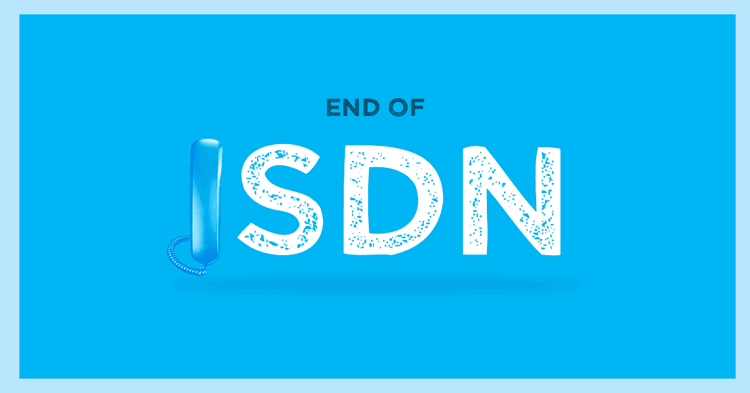
28 November 2018

In actual fact the dismantling of the ISDN network is already underway. Telstra stopped selling new ISDN services to new users at the start of 2018, and then in June ceased sale of new ISDN lines altogether. The countdown is now on until enforced disconnections start on 30 September 2019.
| 31 January 2018 | No New ISDN services | If you didn't already have ISDN services, you were no longer able to purchase an ISDN service. |
| 30 June 2018 | No new modifications or additions | New ISDN services no longer able to be purchased |
| September 2019 | Disconnection starts | Telstra will start disconnecting existing ISDN services |
| 2022 | No further support | Telstra will stop supporting all ISDN2, ISDN2 Enhanced, ISDN10/20/30, DDS Fastway, Megalink and Frame Relay services. |
Telstra announced recently that the following products will no longer be sold and will be disconnected entirely by 2022: The first enforced disconnections will start in September 2019.
ISDN lines are going. For some premises this will occur in a matter of months. For others, the enforced disconnection date could be further away with the entire network shutdown by 2022.
VoicePlus is advising customers to prepare for the shutdown of ISDN well before the predicted disconnection date in their area. In most cases, it makes sense to replace ISDN lines when the premises becomes nbn-ready, and at the same time as migrating any PSTN lines to nbn.
This ensures your business does not get caught in the bottleneck that is coming due to many premises leaving their transition until the last minute. It also minimises the chance of disruption or downtime to your business.
We have written a Best Practice Guide for ISDN Disconnection and Migration. It delivers all the facts without exaggeration or trying to sell you something.
A brief overview of the key steps are outlined below.
Step 1: Audit your current infrastructure
How does your staff access data? How are incoming calls directed? How is your phone system actually set up? How does your messaging work? Would your business benefit from cloud-IVR, or voicemail to email capability?
In short, consider what hardware your team is working with right now and if it needs an upgrade. Keep in mind that older PBXs might function with SIP, but your business could be better off with IP phones to access advanced IP Telephony features. It all depends on your business goals.
Step 2: Build your migration plan
Lean on your telephony partner to discuss the options for your migration, any hardware that might require upgrading, the pricing and the timeframes involved. If you don't have a partner, contact VoicePlus for assistance.
Step 3: Choose your Network Provider
SIP presents an opportunity to revolutionise your communications with a more flexible, scalable technology that offers immediate benefits.
Your network provider needs to be accountable to not only port your numbers over to a new service, but ensure the ongoing delivery of secure and reliable services for your staff and customers.
Points to consider are:
Step 4: Consider using a Specialist Managed Migration Service
There are two reasons to consider using a specialist managed migration service such as offered by VoicePlus.

VoicePlus provides a fully managed ISDN migration and NBN migration service.. We will complete all the operational tasks and manage your business migration with minimal input from your IT resource.
We will manage the order build, equipment supply, on-site network technicians, and network service connectivity. We stay with you from start to finish. Pricing and scope of works

For those of you that don’t speak 'telco', below is a non-technical description of the three technologies.
PSTN
PSTN is the same phone line most people have at home, that sends voice data over copper phone lines, and while things may have changed over the years, PSTN is a very, very old technology, dating back to the first telephone networks of the late 19th Century.
ISDN
ISDN, on the other hand, has only been around since the 1980’s so, by comparison, is relatively young. ISDN is used for voice and data services which can be delivered simultaneously on digital lines. When launched, ISDN technology was applauded for supporting video conferencing and giving the fastest possible internet connections, up to a then blistering 128 kbps!
Now of course there are other, more advanced (and faster) technologies that can provide these sorts of services so the unique selling points for ISDN are now no longer unique.
Cheaper and more efficient solutions include VOIP (Voice over Internet Protocol) for your voice calls, and/or SIP (Session Initiated Protocol) for combined internet and voice.
SIP, or Session Initiation Protocol, is technology that facilitates calls over data networks to other SIP users or into the public switched telephone network (PSTN). When talking about it, you’ll typically hear the term ‘SIP trunking’ which is a direct connection between your business and an Internet telephony service provider (ITSP). Most notably, this connection allows for Voice over Internet Protocol (VoIP), making video conferencing a simple step to move to when you are ready.
The good news is that SIP comes with benefits of greater speed, versatility and portability, which is why telco firms around the world are leading the switch.
Technology changes can be tricky but also come with plenty of opportunity for business. For instance, a move to SIP will rationalise your communications into a single platform and interface, and that’s always an attractive proposition.
NBN
NBN or the National Broadband Network at it simplest level is replacing the old copper lines with a fibre network. VoicePlus is an accredited nbnTM Business Adviser. We specialise in nbnTM migrations and have moved thousands of business sites to nbn.
3 Strategies to Reduce Telecom Cost